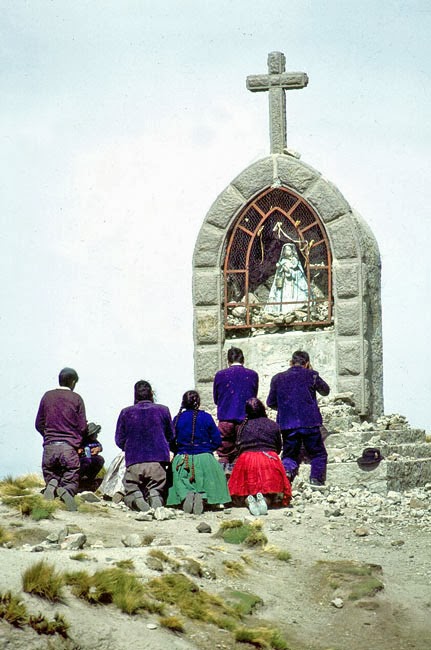--
Ile de Ua Pou
Travels in the Marquesas Islands
Hereafter is another extract of the chapter I wrote
for the 1982 National Geographic book,
Secret Corners of the World, I posted the first extract on this blog on August 1,
2013.
I must leave Tahuata by speedboat--the taxi of the
Marquesas today to catch the weekly plane from Atuona to Ua Pu, next
island on my route. In July, unfortunately, the sea is rough on any day,
and often worse. The speedboat trip takes only an hour, but
over the mad billows of the Bordelais Channel, a narrow corridor between
Tahuata and Hiva Oa. Here waters that have gained unchallenged speed in their
long race from South America must suddenly
meet waves surging back from the coasts.
The waves heave us up
and drop us and drench us.
The pilot speeds up to avoid the biggest ones and slows down as we drop in seemingly bottomless hollows.
Sometimes he cannot muster enough power from his motor to pull us over these mountains of water; he must veer
horizontally below the crest. Off
Teaehoa Point he almost loses control of the boat. Coming from every direction, the waves toss it about like a
nutshell and almost swamp it twice.
If the motor fails, they will break us on the rocks, for the pilot runs close inshore. Marquesans do this to limit the
swimming distance in case of shipwreck--thus
increasing the risk of capsizing. But soon we are in normal sea again. Heavy, but predictable, sea.
With volcanic towers, pinnacles, and spires, Ua Pu emerges from sea
and clouds like a fairy castle. No forests shroud its valleys, for it lies in
the rain shadow of its sister islands, but it will provide incidents as varied
as those of a folk tale.
On the landing strip, a young
man in a jeep radios to the French pilot the speed of the wind, often too
strong for landing. Then he drives up and down the strip to keep 23 horses off
of it. He takes me down to the village of Hakahau, where his mother, a sturdy
matron called Rosalie, will give me pension--room
and board.
She serves the meals at one
end of a large terrace, by a big color TV set that attracts thirty or forty
viewers every night. At the other end stands a small altar, with two statuettes
of the Virgin Mary garlanded with flowers and shells. Here at 6 a. m. the
family prays for half an hour each morning.
Every house in Hakahau seems
to display such a shrine. So strong is Roman Catholicism in the Marquesas that
some have called this group "the Spain of Polynesia," and in Ua Pu
the French priest is especially active.
Now Hakahau is preparing for
Bastille Day. Four wooden structures are rising next to the town hall, to house
restaurants and a ballroom.
Taporo II, a sailing vessel, arrives
and stirs a burst of excitement. A dinghy shuttle runs to the quay, where a
jeep shuttle takes over: canned goods, wine, soap, a bicycle-all the
necessities of modern life. Then the jeep brings copra for the schooner to take
to market. A French couple tell me that if two or even three schooners arrive
at the same time, a mad competition for copra begins. Rumors are spread,
destinations become secret, and passengers are accepted for one island when the
boat will go to another.
Bastille Day comes at last.
As I sit eating dinner, a man who has already celebrated freely comes up
shouting that he wants a word with the stranger. Rosalie rebukes him. He
insists. She fends him off. He comes back. I am amused, but Rosalie loses
patience. She strides up to him, lifts him in her strong arms, carries him to
the street, and dumps him on his face. The TV viewers cheer. I think it tactful
to slip away.
As I stroll down to the town hall, another
drunk approaches me.
"You look German,"
he says. "Heil Hitler! Could you then explain to me what Hitler meant by
'To be or not to be'?"
I tell him that he has his authors mixed up, and leave him cogitating.
Inside the ballroom, colored
lights and blaring American music seem to make the girls shyer than ever. They
refuse to leave their benches; the boys, undaunted, dance together. Outside,
children and dogs enjoy themselves tremendously. The children are fascinated by
the glitter, the unusual festivity. The dogs sniff the air eagerly; I watch
four of them nibble at the meat of a brochette vendor absorbed by the dancers'
antics. By ten o'clock even the girls are dancing. More people are coming in
all the time. And everyone, generally so distant, greets me with surprising warmth.
It seems appropriate, on this fairy-tale castle of an island, that people
should throw off their deep reserve for one night in the year.
This young woman interrupted
her cooking to greet me
--
Cette jeune femme interrompit sa cuisine pour me
saluer
Trimming a hat this young
woman wove from pandanus leaves
-
jeune
femme Finissant un chapeau de paille de pandanus qu’elle a tissé
Shopkeeper ironing a man’s shirt
--
Epicière repassant une
chemise d’homme
Pulling baguettes out of a stone
oven. They are as good as any in Paris. And so are those I ate in several French
West African countries. Why can’t America produce any worth the name?
--
Retirant
des baguettes d’un four de pierre.
Finishing a mat she wove from
pandanus leaves
--
Finissant une natte qu’elle a tissée
de feuilles de pandanus
Hakau Bay. Weighing bags of
copra that will be loaded on a visiting schooner.
--
Baie d’Hakau. Pesant du copra a
charger sur un voilier de passage.







































